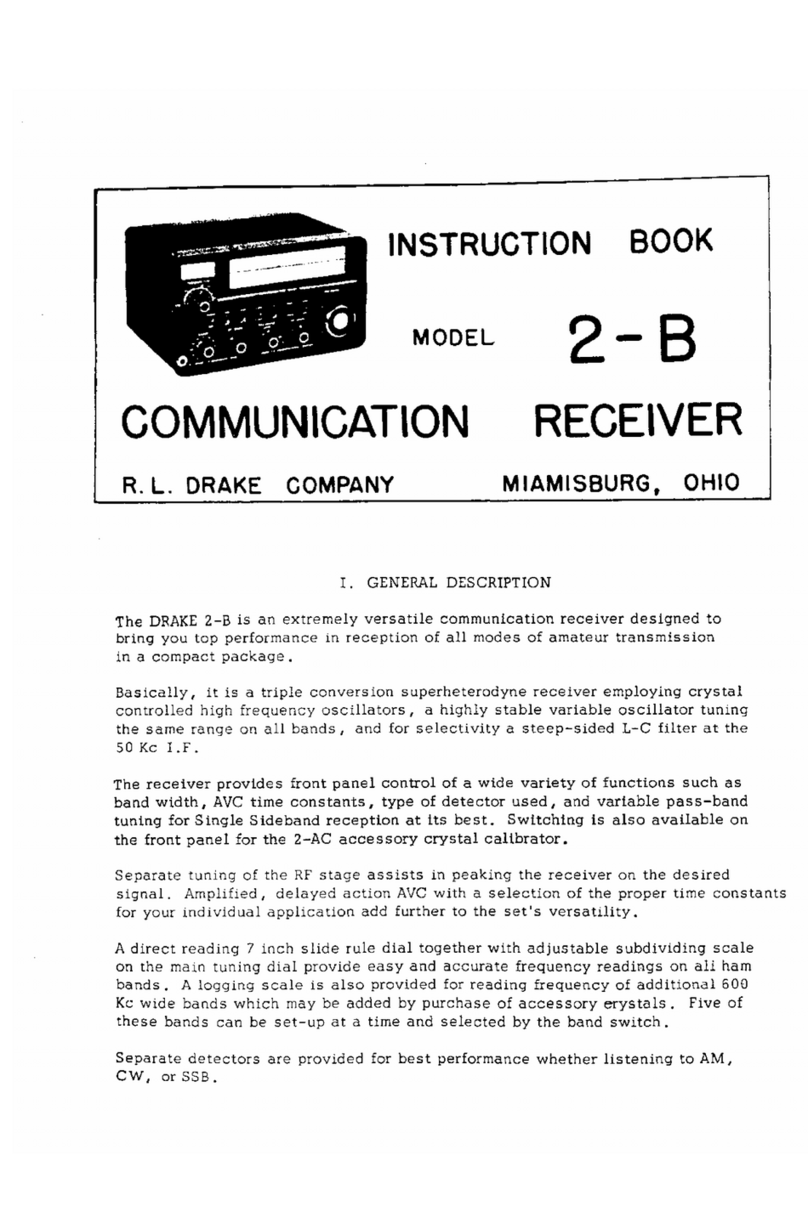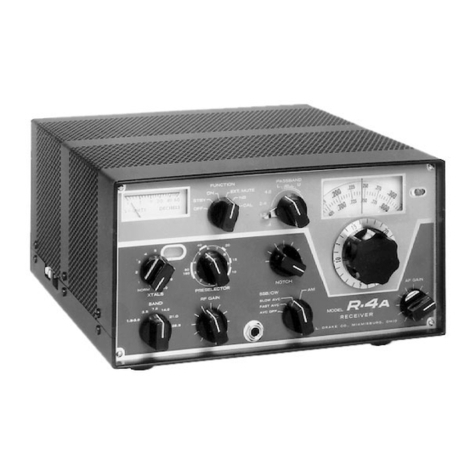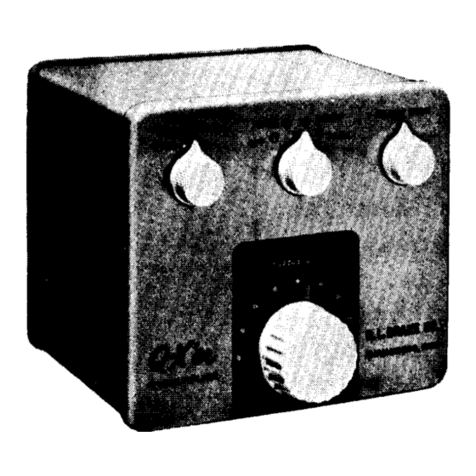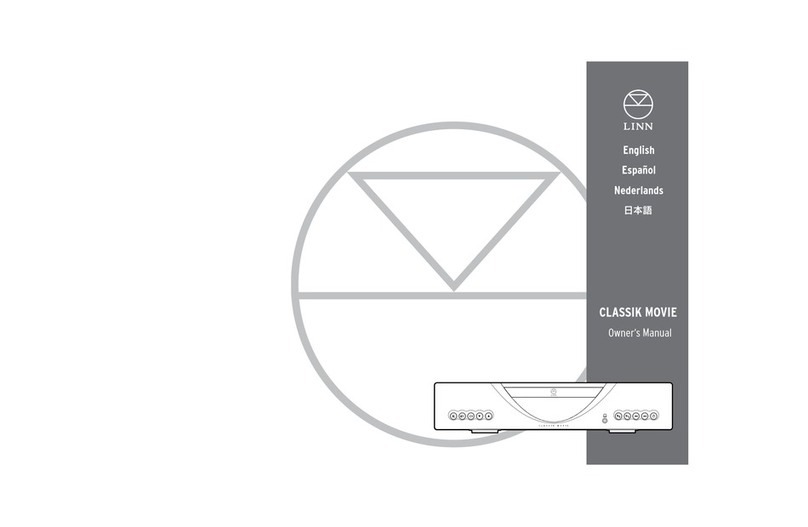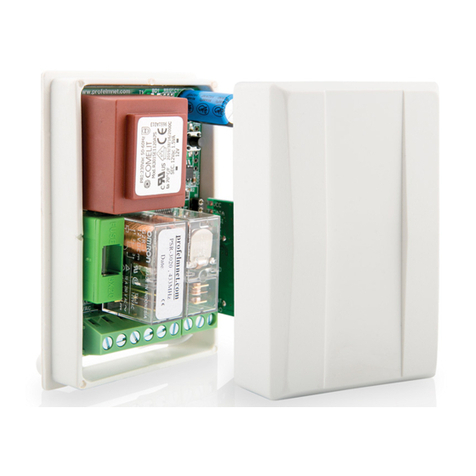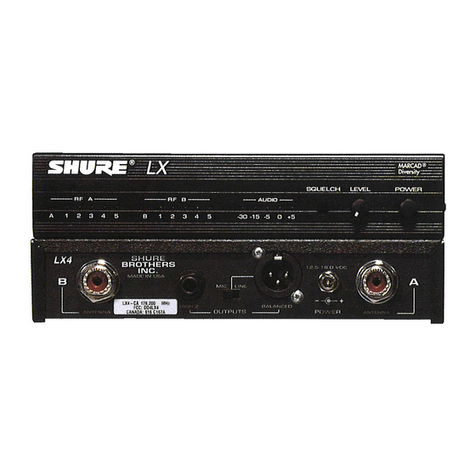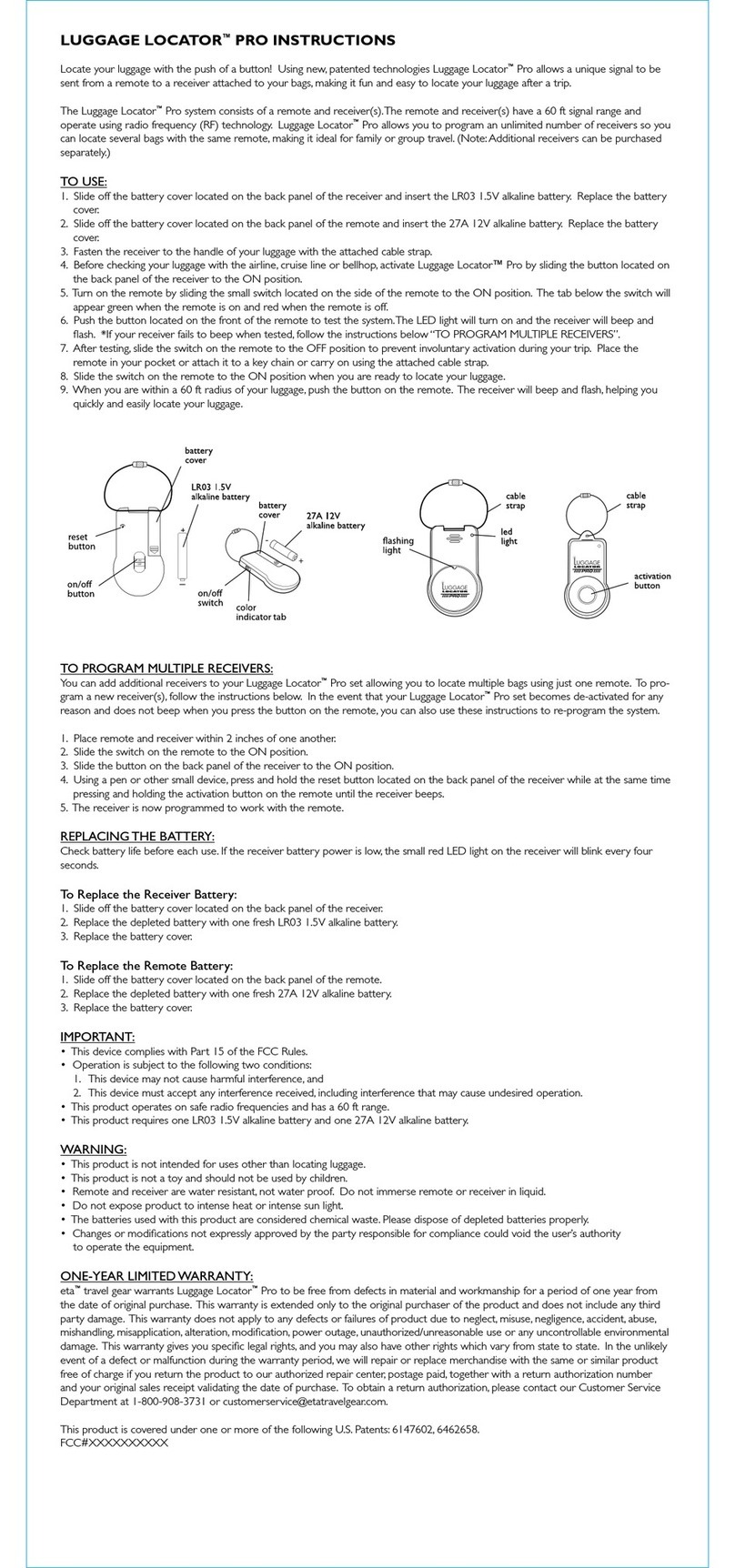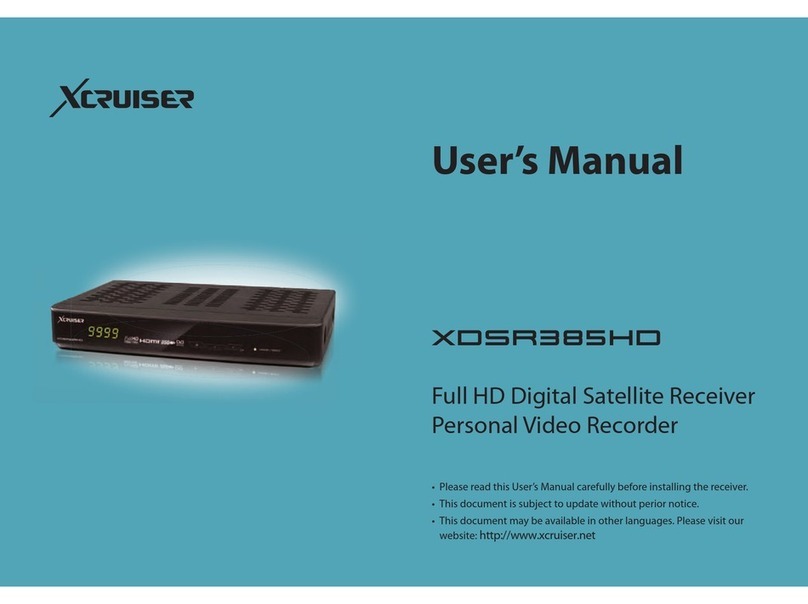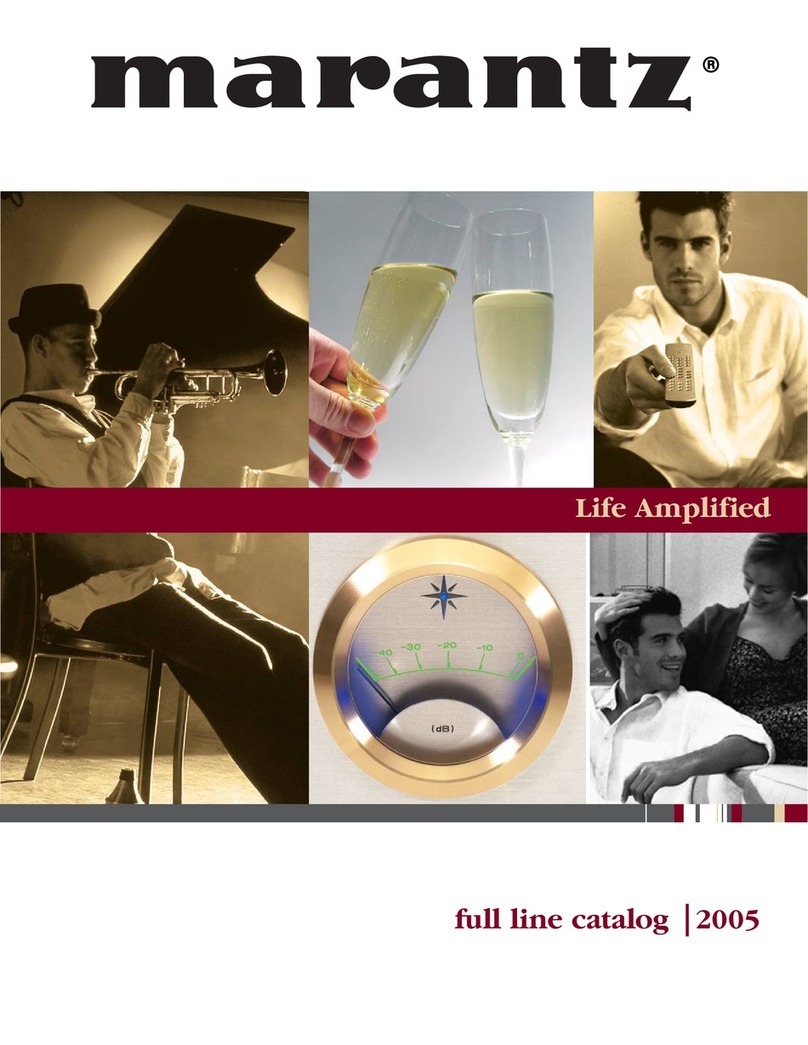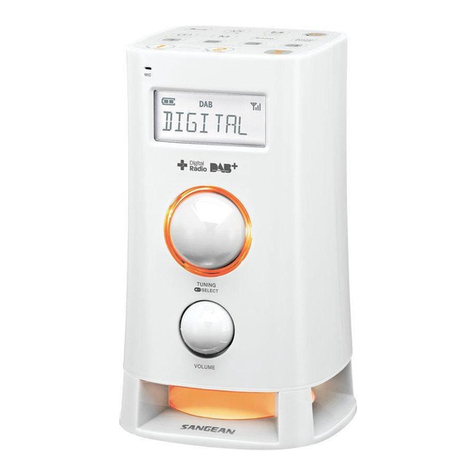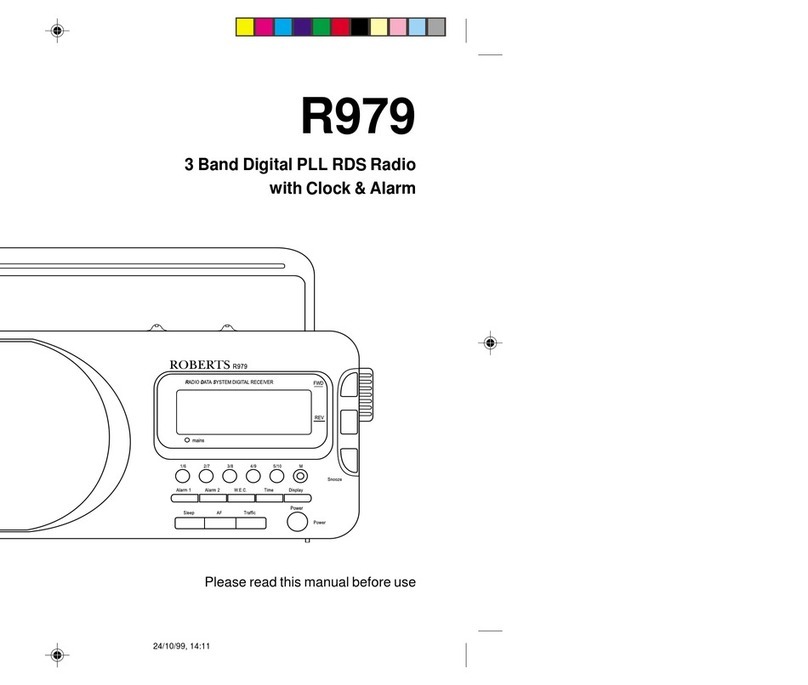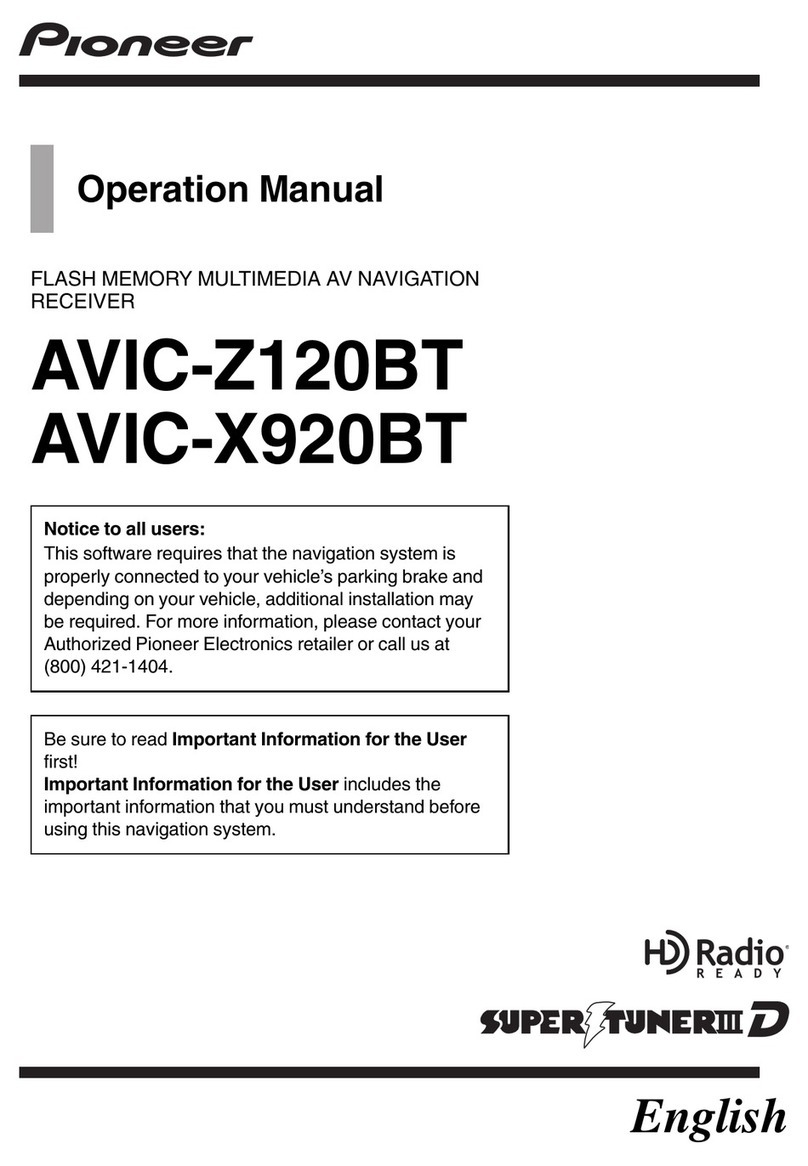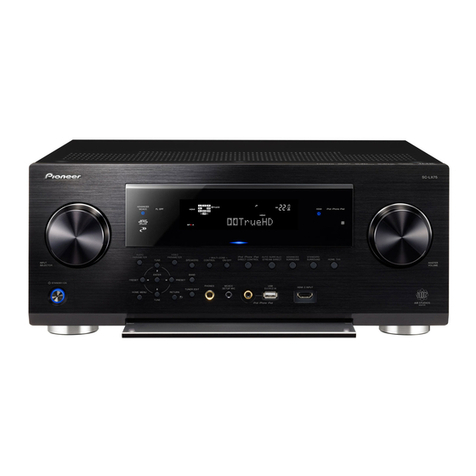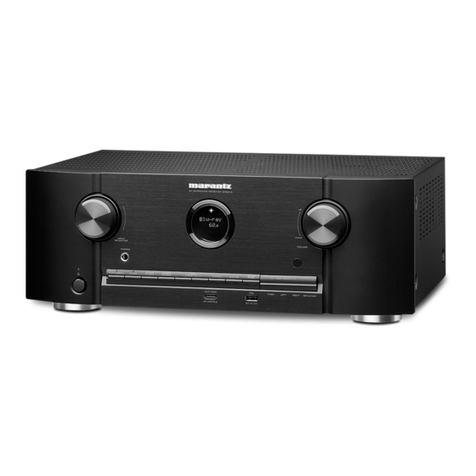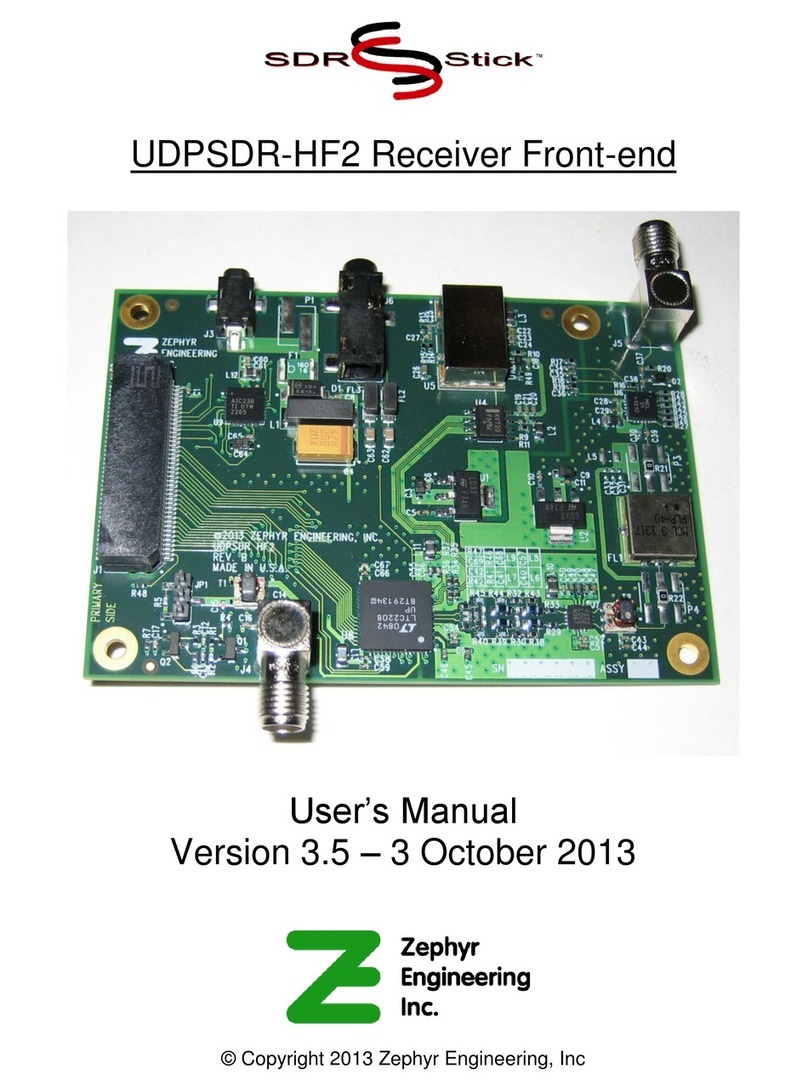R.L.DRAKE 1-A User manual

INSTRUCTION
BOOK
MODEL
I-A
SIDEBAND
RECEIVER
Lr
(eae
R.
L.
DRAKE
COMPANY
MIAMISBURG,
OHIO
I.
GENERAL
A.
GENERAL
DESCRIPTION
The
R.
L.
Drake
Model
1-A
is
an
amateur-band
receiver
designed
for
single
sideband
reception.
No
compromise
has
been
made
in
its
excellent
sideband
performance
in
an
effort
to
receive
other
types
of
transmission,
The
important
requirements
for
good
sideband
reception
which
are
fulfilled
by
the
1-A
are
frequency
stability,
proper
AVC
action,
continuous
sideband
tuning,
correct
passband
and
aydio
response
characteristics,
distortion-free
product
detection,
reasonable
tuning
rate,
and
instantaneous
muting
and
recovery.
With
respect
to
these
points
and
to
simple,
functional
design,
this
receiver
sets
new
standards
in
sideband
reception.
The
receiver
also
works
very
well
on
CW
due
to
the
similarity
between
the
requirements
for
reception
for
CW
and
SSB.
Almost
every
feature
built
into
the
1-A
for
SSB
is
also
desirable
for
CW.
AM
signals
are
treated
just
like
SSB.
The
highly
selective
filter
removes
all
but
one
sideband;
then
detection
is
the
same
as
for
SSB.
In
many
respects.
this
type
of
AM
reception
is
superior
to
that
using
envelope
detection.
The
outward
appearance
of
the
1-A
is
modern,
functional
and
worthy
of
its
well-engineered
contents.
The
uniquely
shaped
cabinet
is
designed
to
occupy
a
minimum
of
desk
space.
The
receiver
is
made
self-sufficient
by
including
an
internal
speaker.

MODEL
1-A
SINGLE
SIDEBAND
RECEIVER
--
REFERENCE
DATA
OPERATING
RANGE:
Seven
600
ke
tuning
ranges
cover
five
"ham"
bands:
80M
(3.5
-
4.1
mc),
40M
(7.0
-
7.6
mc),
20M
(14.0
-
14.6
mc},
15M
(21.0
-
21.6
mc},
10M
(28.0
-
28.6
mc),
10M
{28.5
-
29.1
mc},
10M
(29.1
-
29.7
mc}-
eleo
WWV-10
mc.
DETECTION:
Product
Detector
for
SSB,
CW,
and
AM
by
exalted
carrier
method,
MAIN
DIAL:
Dial
is
marked
in
10
ke
divisions;
frequency
can
be
estimated
to
Lor2kc,
Pointer1s
:vovable
to
make
accurate
calibrations.
Bifective
scalc
length
1s
8.3
inches.
MAIN
TUNING:
Concentric
tuning
knobs
provide
two
tuning
rates:
4-1/2
tums
for
600
kc
and
30
turns
for
600
kc.
Tuning
rate
is
the
same
for
all
bands.
STABILITY:
High
stability
VFO
unit
operates
without
switching
or
ganging
through
seme
frequency
range
for
all
bands.
Warm
up
drift
is
less
than
300
cps
after
15
minutes
operation,
Crystal-controlled,
high
frequency
conversion
establishes
this
same
stability
for all
bands.
SENSITIVITY:
Less
than
l
uv
for
20
db
s/n.
ANTENNA
ATTENUATOR:
30
db.
Switch
provided
to
switch
pad
in
or
out.
SELECTIVITY:
Multi-section
sideband
filter
provides
selectivity
as
follows;
2.
5kcat6db-
8.l
kc
at
60db.
Sideband
tuning
control
moves
filter
response
up
to
3
kc
above
or
below
the
fixed
carrier.
§
METER:
Meter
calibrated
in
"S"
units
to
$9
and
20, 40,
60
db
over
39.
$9
represents
approximately
100
uv
at
the
antenna
input,
"S"
units
are
at
approximately
6
db
intervals.
Properly
damped
meter
movement
for
steady
readings.
AVC:
Amplified-delayed
AVC.
Integrating
dual-action
time
constant
circuit
gives
fast
charge,
slow
discharge
for
modulation,
but
fast
charge,
fast
discharge
on
short
puises.
This
provides
some
noise
limiter
action,
AF
RESPONSE:
Down
approximately
20
db
at
65
and
6200
cps
Down
approximately
6
db
at
200
and
3500
cps
AP
OUTPUT:
To
internal
speaker
or
4
ohms
to
external
speaker,
headphones,
and
transmitter
anti—trip.
RF
INPUT
IMPEDANCE:
To
match
0-75
ohm
coax
line

CRYSTAL
CALIBRATOR:
Provides
markers
at
100
kc
intervals
across
ali
bands,
Off-on
switch
is
part
of
ANTENNA
TRIMMER
control.
DIMENSIONS:
6-3/4"
wide
x
11"
high
x
15"
deep
WEIGHT:
18
pounds
NUMBER
OF
TUBES:
Thirteen:
6BZ6
Ist
RF
--
6BE6
Ist
mixer
--
6BE6
2nd
mixer
--
6BY6
3rd
converter
--
6BZ61F
--
12AU7
product
detector
--
6BJ8
AVC
amplifier
and
rectifier
--
GAB4
crystal
oscillator
--
6BQ7A
V.F.
oscillator
--
12BA6
calibrator
oscillator
--
12AU7
L.F.
oscillator
and
lst
AF
12AQ5
AF
output
--
12X4
rectifier.
FRONT PANEL
CONTROLS:
Band
switch
-
Main
Tuning
-
Sideband
Tuning
-
Antenna
Trimmer/
100
ke
calibrator
-
RF
Gain/
Standby
Switch
-
AF
Gain/
Power
Switch
BACK
PANEL
CONTROLS
AND
TERMINALS:
S-meter
zero
adjust
-
Antenna
Attenuator
Switch
-
SO
239
Antenna
connector
-
Muting
connector
External
speaker/
phone
jack
-
4
ohm
AF
Output/Internal
speaker
input.

IL.
INSTALLATION
A,
POWER
-
The
1-A
is
designed
for
operation
from
[05
-
125
volts,
60
cycles,
A-C
ONLY
and
consumes
50
watts.
OPERATION
FROM
LOWER
POWER
LINE
FREQUENCIES
OR
HIGHER
POWER
LINE
VOLTAGES
WILL
DAMAGE
THE
POWER
TRANSFORMER
AND
VOID
THE
GUARANTEE.
Note:
It
is
not
advised
that
the
I-A
be
used
for
a
mobile
receiver,
The
moisture
condensation
due
to
extreme
temperature
changes
will
eventually
affect
the
stability
of
the
VFO.
However,
if
the
[-A
is
used
in
mobile
service,
power
can
be
obtained
from
a
50
watt
inverter.
B.
LOUDSPEAKER
-
A
good
external
speaker
is
recommended
for
fixed
station
use,
A
specially
designed
communications
speaker
has
been
built
into
the
I-A
for
portable
use,
This
speaker
is
connected
to
the
AUDIO
IN
and
GND
screw
terminals
on
the
back
of
the
receiver,
When
it
is
desired
to
use
the
built-in
speaker,
a
jumper
is
placed
from
the
AUDIO
IN
screw terminal
to
the
AUDIO
OUT
screw
terminal,
If
it
is
desired
to
use
an
external
speaker,
this
Jumper
is
removed
and
the
external
speaker
wires
connected
to
the
AUDIO
OUT
and
GND
screw
terminals,
The
output
impedance
of
the
[~A
is
4
chms.
C.
MUTING
-
NOTE:
THE
EXTERNAL
MUTING
SHOULD
BE
USED
IN
ALL
CASES
WHEN
THE
1-A
IS
USED
WITH
A
TRANSMITTER.
An
RCA
phono
jack
is
provided
on
the
back
of
the
receiver
for
this
external
muting.
This
biases
the
r-f
tubes
in
the
1-A
to
cut
off
when
transmitting
and
prevents
the
AVC
condenser
from
charging
up
which
would
cause
a
slow
return
to
receive
after
transmitting.
The
switch
on
the
RF
GAIN/STANDBY
control
is
in
parallel
with
the
MUTE
jack
and
should
be
pushed
in
to
open
the
switch
and
allow
the
external
switch
or
relay
contact
to
perform
this
function.
A
shielded
wire
should
be
soldered
into
the
phono
plug
in
the
MUTE
jack.
The
hot
wire
should
go
to
an
exciter
auxiliary
relay
contact
which
is
open
when
transmitting
and
grounded
when
receiving.
A
set
of
auxiliary
contacts
on
the
antenna
relay
may
he
used
for
this
purnose
by
connecting
the
shield
to
one
contact
and
the
hot
wire
to
the
other,
lf
the
I-A
is
used
with
a
voice
controlled
exciter,
wires
should
be
run
from
the
AUDIO
OUT
and
GND
screw
terminals
to
the
exciter
terminals
to
which
the
exciter
manufacturer
recommends
the
receiver
be
connected
,
This”
connection
is
for
t
operation
oft
the
antitrip
galy
aoa
nee
break
the
speaker
1
ROT
2
-4-

When
using
a
phone
patch
such
as
the
R,
L,
Drake
Model
584,
it
1s
not
necessary
to
mute
the
speaker
lead.
When
the
bias
muting
is
connected
properly
there
is
no
audio
at
the
output
terminals.
It
is
only
necessary
to
connect
the
phone
patch
in
the
speaker
leads
and
run
a
wire
to
the
exciter
anti-trip.
D.ANTENNA
-
The
antenna
input
impedance
of
the
1-A
is
50-75
ohms.
It
1s
recommended
that
the
receiver
be
fed
with
a
coax
line
which
is
matched
to
a
resonant
antenna
either
directly
or
through
balun
coils
or
antenna
tuner.
Feeding
the
receiver
from
high
impedance
line
or
@
non-resonant
antenna
will
result
in
an
apparent
loss
in
sensitivity.
Antenna
relay
1s
recommended
for
use
with
your
receiver
and
transmitter,
This
will
permit
you
to
use
your
best
antenna
on
your
receiver
as
well
as
the
transmitter,
The
use
of
a
separate
receiving
antenna,
a
TR
switch
of
usual
design,
or
an
unshielded
line
between
the
receiver
and
the
antenna
relay,
will
permit
a
large
signal
to
enter
the
receiver
when
you
transmit,
This
will
probably
not
harm
the
receiver,
but
it
may
interfere
with
the
Instantaneous
restoration
of
reception
after
transmitting.

Til.
OPERATION
A
CONTROIS
i.
BAND
SWITCH
-
Used
to
select
desired
frequency
band,
Bands
covered
are:
80M
(3.5
~
4.1
mc),
40M
(7.0
-
7.6
mc),
20M
(14,0
-
14.6
mc),
15M
(21.0
~
21.6
mc),
10M
(28.0
-
28.6
me),
10M
(28.5
-
29.1
me),
10M
(29.1
-
29.7
me)
-
also
9.9
-
10,5
mc
for
WWV.
2,
MAIN
TUNING
-
Used
to
select
desired
frequency.
(a)
The
large
knob
is
the
fast
tuning
knob
and
covers
approximately
120
ke
per
revolution.
This
knob
is
normally
used
only
when
moving
from
one
part
of
the
band
to
ancther.
(b)
The
small
knob
is
the
slow
tuning
knob
and
covers
approximately
20
ke
per
revolution.
This
knob
is
normally
used
when
tuning
a
small
portion
of
the
band.
(c)
The
tuning
dial
is
marked
in
10
ke
divisions
and
the
frequency
can
be
estimated
to
1
or
2
kc.
NOTE:
The
dial
pointer
is
movable
from
the
front
panel
to
make
accurate
calibrations.
3.
SIDEBAND
TUNING
-
Used
to
select
desired
sideband.
The
white
band
painted
on
the
knob
represents
the
passband
of
the
receiver.
The
center
line
on
the
front
panel
represents
the
fixed
reinserted
carrier
-
other
divisions
are
approximately
1
kc
each,
(a)
For
LOWER
SIDEBAND
reception,
the
right
edge
of
the
white
band
should
be
set
to
the
center
line
on
the
front
panel.
(b)
For
UPPER
SIDEBAND
reception,
the
left
edge
of
the
white
band
should
be
set
to
the
center
line
on
the
front
panel.
Note
that
these
are
the
recommended
settings.
However,
|t
may
be
advantageous
to
set
the
sideband
tuning
slightly
higher
or
lower
than
these
settings
to
make
the
incoming
signal
sound
more
natural
or
to
“drop
an
interfering
hetrodyne
off
the
edge
of
the
passband",
It
is
not
necessary
to
retune
the
MAIN
TUNING
when
moving
the
SIDEBAND
TUNING
knob
since
this
is
NOT
a
bfo
pitch
control.
When
you
adjust
this
knob,
you
are
actually
moving
the
50
kc
pass-
band
about
the
fixed
reinserted
carrier
frequency.

4.
ANTENNA
TRIMMER/
100
KC
CALIBRATOR
SWITCH
-
5.
(a)
(b)
RF
(a)
Antenna
Trimmer
—
Used
to
peak
an
This
control
should
be
adjusted
for
maximum
signal
strength
of
the
incoming
signals
or
adjusted
for
maximum
noise
when
no
signal
is
present.
NOTE:
The
antenna
trimmer
on
the
1~A
tunes
much
sharper
than
on
most
receivers,
It
must
be
set
very
carefully
to
obtain
best
reception
and
least
interference.
100
KC
Calibrator
Switch
-
With
the
pointer
on
the
ANTENNA
TRIMMER
knob
set
anywhere
in
the top
half
of
the
rotation,
the
calibrator
is
OFF,
With
the
pointer
set
anywhere
in
the
bottom
half
of
the
rotation,
the
calibrator
is
ON.
GAIN/STANDBY
SWITCH
-
RF
GAIN
-
Limits
the
sensitivity
of
the
receiver
at
no
signal,
This
control
is
normally
set
fully
clockwise,
However,
back-
ground
noise
between
transmissions
can
be
reduced
by
backing
off
this
control
slightly.
The
position
of
the
RF
GAIN
control
does
not
affect
the
audio
volume,
AVC
action,
or
S-meter
reading
so
long
as
the
control
setting
is
such
that
the
incoming
signal
still
moves
the
S-mcter.,
Backing
off
this
control
heyond
the
point
where
the
incoming
signal
will
move
the
S-meter
serves
NO
useful
purpose
and
may
cause
a
blast
of
noise
when
recovering
from
the
muted
condition,
This
is
due
to
charging
the
AVC
through
the
high
impedance
RF
GAIN
control
rather
than
the
low
impedance
AVC
circuit.
THE
RF
GAIN
15
NOT
A
VOLUME
GONTROL.
USE
THE
Ar
GAIN
WHEN
IT
IS
NECESSARY
TO
GONTROL
THE
VOLUME.
(b)
STANDSY
SWITCH
-
Mutes
the
receiver,
Pull
knob
outward
for
.
AF
receive
and
push
inward
for
standby.
When
using
external
muting
terminal
on
the
back
of
the
receiver,
the
knob
should
be
pushed
inward.
The
muting
can
be
disabled
at
any
time
by
pulling
the
knob
outward.
This
allows
you
to
monitor
your
own
signal.
GAIN/POWER
SWITGH
-
(a)
AF
GAIN
-
Adjusts
the
audio
gain.
(Volume
control)
,
{b)
POWER
SWITCH
-
Turns
receiver
A-C
power
on
and
off,
Pull
outward
to
turn
receiver
on
and
push
inward
to
turn
off.
-7-

7.
METER
ZERO
~
(On
back
of
receiver)
-
Used
to
adjust
S§-meter
to
zero.
This
control
is
adjusted
with
the
RF
GAIN
control
fully
ciock~
wise
and
the
antenna
disconnected,
8.
ANT.
SW.
(ANTENNA
SWITCH)-
(On
back
of
receiver)
~
Controls
an
L
pad
of
approximately
30
db
in
the
antenna
circuit.
The
pad
will
prevent
strong
signals
not
in
the
passband
from
cros
s~modulating
with
the
signal
being
received,
This
switch
should
be
kept
in
the
down
position
(marked
NORM)
except
for
conditions
of
extremely
strong
signals
found
on
the
lower
frequencies
on
large
antennas
or
when
another
amateur
station
close
by
is
operating
on
the
same
band.
8.
SINGLE
SIDEBAND
RECEPTION
-
.
Pull
AF
GAIN/POWER
knob
outward.
.
Pull
RP
GAIN/STANDBY
knob
outward,
.
Turn
RF
GAIN
knob
fully
clockwise.
.
Turn
AF
GAIN
knob
about
1/4
turn
clockwise
(
9
o'clock).
.
Set
the
BAND
SWITCH
to
the
desired
frequency
range,
.
Rotate
the
MAIN
TUNING
knob
until
the
desired
signal
is
located.
.
Set
SIDEBAND
TUNING
for
sideband
being
transmitted.
,
Adjust
ANTENNA
TRIMMER
for
maximum
signal
strength,
mat
the
AY
GAIN
contro
tc
produce
the
desired
listening
leve
.
§et
the
AP
GAIN
contro!
to
produce
the
desired
Hstening
level.
VeOru
F481
wRwrre
C.AM
RECEPTION
-
Same
as
SSB
reception
above,
Select
sideband
more
free
of
interference.
It
is
sometimes
desirable
to
set
the
SIDEBAND
TUNING
more
off
center
to
reduce
the
carrier
to
an
inaudible
level.
Since
the
sideband
filter
can
be
set
to
attenuate
the
carrier
and
one
sideband
of
the
AM
signal,
the
incoming
AM
signal
is
converted
into
a
SSB
signal,
There
is
no
longer
the
necessity
of
tuning
the
AM
signal
right
“on
the
nose"
to
have
it
sound
right
as
had
to
be
done
in
the
past
with
regular
communications
receivers
when
receiving
AM
with
the
bfo
turned
on.
Since
the
AM
signal
is
now
4
SSB
signal
as
far
as
the
receiver
1s
concerned,
its
sideband
signal
strength
(instead
of
the
carrier
strength)
controls
the
AVC
the
same
way
as
a
SSB
signal
would,
D,
DOUBLE
SIDEBAND-SUPPRESSED
CARRIER
RECEPTION
-
Same
as
SSB
reception
above.
Select
sideband
more
free
of
interference.
FE,
CW
RECEPTION
-
Same
as
SSB
reception.
Rotate
sideband
tuning
for
minimum
interference.

Iv.
GIRCUIT
THEORY
A.
GENERAL
-
Explanation
of
Block
Diagram
The
signal
enters
at
the
left
from
the
antenna
and
is
sharply
peaked
by
high
Q
antenna
coils
and
trimmer
capacitor
which
is
a
front
panel
control,
A
6BZ6
is
used
as
a
low
noise
RF
amplifier.
The
RF
amplifier
plate
circuit
coils
are
fixed
tuned
to
the
center
of
each
band.
The
first
mixer,
a
6BE6,
is
separately
excited
from
the
crystal
controlled
oscillator
(6AB4).
The
2,9-3.5
mc
I.F.
coupler
is
a
double-tuned,
overcoupled
transformer
with
a
bandwidth
of
600
kc.
The
valley
or
dip
in
the
middle
of
this
overcoupled
response
{s
filled
in
by
the
response
of
the
RF
coils
tuned
to
the
middle
of
the
band.
The
second
mixer,
also
a
6BE6,
is
excited
with
the
stable
VFO
unit
(6BQ7-A).
The
VFO
tunes
the
range
of
frequencies
between
4.0
and
4.6
mc.
By
subtracting
the
Ist
I,F.
range
from
the
VFO
range,
you
come
out
with
a
fixed
frequency
of
1100
ke,
the
frequency
of
the
@ndt.F.
The
third
mixer,
a
6BY6,
is
self-excited
from
its
oscillator
section
which
ts
running
at
1050
kc.
The
1050
ke
oscillator
is
mixed
with
the
1100
kc
I.F.
and
the
resultant
output,
50
kc,
passes
through
the
SIDEBAND
FIETER
.
The
passband
of
this
filter
can
be
moved
up
to
3
ke
above
or
below
the
fixed
50
kc
BFO
frequency.
A
6BZ6
is
used
to
further
amplify
the
50
kc
I.F.
signals,
This
L.F.
amplifier
feeds
the
6BJ8
AVG
amplifier
and
the
J2AU7
PRODUCT
DETECTOR.
AVC
voltage
is
applied
to
the
RF
tube,
Ist
and
2nd
mixers,
and
the
50
ke
1.F.
ampiifier.
The
12AU?
product
detector
is
followed
by
a
3
kc
low
pass
filter
which
removes
the
56
kc
BFO
voltage
from
the
audio
and
adds
to
the
selectivity
by
restricting
the
high
audio
frequencies.
The
AF
amplifier
(1/2
12AU7)
and
output
(12AQ5)
stages
provide
the
necessary
audio
gain
and
output
power.
inverse
feedback
and
coupling
circuits
have
been
selected
to
give
flat,
distortion-free
response
and
to
restrict
the
high
and
jow
frequency
response.
-9-

M3AIZ03YN
ONVESAIS
V-|
TSGOW—WVYoVIC
400718
Nivo
—-NIVO
ONINNL
dy
anvassvd
SNINNL
Govel
Lnvel
2nve!
9289

B,
ELECTRICAL
DESCRIPTION
I,
RF
AMPLIFIER
-
(V-1)
This
stage
is
in
the
circuit
on
all
bands,
It
is
a
conventional
circuit
utilizing
a
6BZ6
tube,
a
semi~remote
cutoff
pentode.
The
6BZ6
was
chosen
because
of
its
low
nolse,
high
gain,
and iow
cross-modulation,
The
plate
current
of
this
tube
is
used
to
drive
the
S-meter,
The
signal
grid
{s
connected
to
the
antenna
coils
which
were
designed
for
50-75
ohm
unbalanced
input.
The
ANTENNA
TRIMMER
is
connected
across
the
antenna
coil
secondary
and
tunes
it
to
resonance.
The
signal
grid
is
returned
to
the
AVC
line
through
a
2,2
megohm
resistor
to
prevent
possible
damage
to
the
tube
through
grid
current,
The
gain
of
the
RF
amplifier
is
sufficient
to
amplify
the
front
end
noise
to
a
level
which
will
blanket
the
noise
from
mixers
further
along
in
the
circuit,
This
means
that
full
advantage
is
taken
of
the
low
noise
RF
stage.
The
plate
circuit
{s
tuned
to
resonance
with
the
RF
coils.
They
are
tuned
to
the
center
of
each
band.
Since
the
2.9
-
3.5
mc
coupler
has
a
peak
on
each
end
of
the
band
and
a
dip
or
valiey
in
the
middle,
peaking
the
RF
coils
in
the
middle
of
the
band
fills
the
“valley”
and
produces
a
flat
response
curve
across
the
whole
band.
.
lst
MIXER
-
(V-2)
-
This
stage
utilizes
a
6BE6
tube,
The
signal
grid
1s
capacitively
coupled
to
the
plate
of
the
RF
amplifier
and
is
returned
through
a
68,000
ohm
resistor
to
the
AVC
line.
This
stage
used
some
cathode
bias
in
the
form
of
a
cathode
resistor
to
increase
the
bias
and
reduce
the
gain
to
prevent
cross—
modulation
from
strong
signals.
The
injection
arid
is
separately
excited
from
V-3,
the
crystal-
controlled
oscillator,
The
plate
circuit
1s
coupled
to
the
2nd
mixer
through
the
2.9
-
3.5
mc
band-passed
coupler.
CRYSTAL
OSCILLATOR
-
(¥-3}
-
This
stage
utilizes
a
GAB4
tube
operating
as
3
grounded
grid
oscillator
with
the
plate
circuit
parallel
resonant
at
the
crystal
overtone
frequency
that
is
desired.
-ll-

The
crystal
is
connected
between
a
low
impedance
capacity
tap
of
the
resonant
circuit
and
the
cathode
of
the
tube.
The
crystals
all
operate
on
overtones
except
X1
which
is
on
the
fundamental,
The
output
from
Xi
is
quite
high
so
extra
tuning
capacity
and
resistance
load
is
used
to
keep
the
drive
down.
X2
1s
a
3500
kc
fundamental
crystal
but
it
1s
operated
on
its
3rd, Sth,
7th,
and
9th
overtones
by
switching
the
plate
coil.
Therefore,
crystal
control
may
be
had
on
four
bands
with
only
one
crystal,
The
output
is
fed
to
the
mixer
from
the
low
impedance
point
in
the
circuit
so
that
there
is
no
oscillator
pulling,
.
2nd
Mixer
-
(V-4)
-
This
stage,
a
6BE6,
is
excited
from
the
stable
VFO
unit,
The
signal
grid
is
connected
to
the
2.9-3.5
MC
coupler
which
is
returned
to
the
AVG
line,
Its
plate
is
coupled
to
the
converter
tube
signal
grid
through
two
double
tuned
I,F.
transformers
at
1100
mc.
.
VFO
-
(V-5)
-
This
stage
utilizes
a
6BQ7A,
which
was
selected
for
its
high
"Figure
of
Merit".
That
is
a
large
gm
to
internal
capacity
ratio.
The
large
gm
allows
very
loose
coupling
of
the
tube
to
the
tuned
circuit
and
thereby
minimizes
its
effect
on
the
frequency.
Some
cathode
degeneration
was
also
added
to
further
isolate
the
effects
of
the
tube.
One
half
of
the
tube
is
used
as
the
oscillator
and
the
other
half
is
used
as
a
buffer
amplifier
to
isolate
the
VFO
from
the
mixer
and
to
provide
low
impedance
output.
.
3rd
MIXER
-
(V-6)
-
A
6BY6
was
selected
for
this
stage
because
of
the
unusually
high
conversion
gain
that
it
provides.
ub
4
g
3
oO
ist
o
ie]
a
y
o
ia
o
=
gq
wn
QO
rh
In
this
converter
with
Its
oscillator
section
running
at
1050
kc,
the
signal
is
beat
down
to
50
kc.
The
plate
is
connected
to
the
sideband
tuner/filter.
~
124

7,
SIDEBAND
TUNER/FILTER
-
This
unit
is
made
up
of
four
resonators.
These
resonators
are
identical
and
are
all
tuned
to
the
same
frequency.
The
coupling
capacitors
are
critical
in
size
since
they
determine
the
band
width
and
the
flatness
of
the
response,
This
filter
is
the
electrical
equivalent
of
a
mechanical
filter.
It
is
designed
the
same
way,
using
the
same
formulas.
The
resonators
are
slug
tuned
and
ganged
to
the
sideband
tuning
contro]
so
that
the
response
can
be
moved
up
or
down
in
frequency
without
changing
the
shape
of
the
passband.
8.
t.
F.
AMPLIFIER
-
(V-7)
-
This
stage
utilizes
a
6BZ6
and
is
used
to
amplify
the
50
kc
signals
to
the
level
required
by
the
product
detector,
Its
signal
grid
is
connected
to
the
Sideband
Tuner/Filter
and
its
plate
1s
broadly
tuned
to
resonance
by
a
50
ke
I.F.
coil.
AVC,
RF
GAIN,
AND
MUTING
CIRCUIT
section
is
used
as
an
AVC
amplifier
tube
for
the
AVC
condenser.
The
6BJ8
(¥-9)
triode
low
impedance
charging
a
w
5
a
|
=
There
are
two
separate
AVC
voltages
produced
by
this
circuit.
One
is
applied
to
the
RF
and
mixer
tubes.
The
second
is
applied
to
the
I.F.
tube
only,
The
difference
in
these
two
AVC
supplies
is
in
their
attack
and
release
time
constants.
AVC-1
charges
C-66
through
R-45
plus
the
tube
plate
resistance
in
about
20
milliseconds.
It
discharges
through
R-46
in
one
second.
AVG-2
charges
C-64
through
the
tube
plate
resistance
only,
in
about
160
microseconds
and
discharges
through
R-45
in
less
than
one
miilisecond,
if
there
is
no
charge
In
C-66.
ANC-2
charges
rapidly
to
kill
the
"pop"
and
controls
the
gain
until
AVC-1
has
time
to
charge;
then
both
circuits
work
together
as
one,
On
a
short
pulse,
only
AVC-2
has
time
to
charge.
Its
fast
action
tends
to
reduce
the
sound
of
the
noise
and
its
fast
release
leaves
no
dead
space
after
the
pulse.
So,
the
AVC
system
as
a
whoie
provides
an
attack
time
of
about
160
microseconds
and
a
release
time
of
one
second.
~13-

At
the
same
time,
it
is
unobstructed
by
noise
pulses
and
actually
provides
some
miter
action.
The
RF
GAIN
control
applies
a
negative
voltage
in
series
with
AVC
to
limit
the
maximum
sensitivity
of
the
receiver
and
provides
an
equal
voltage
to
delay
the
start
of
AVG
action,
Thus
the
overall
gain
of
the
receiver
is
not
reduced
until
the
RF
GAIN
is
retarded
to
a
point
where
the
S-meter
stops
kicking
upward
with
signal
voltage.
Muting
is
accomplished
by
inserting
4
cutoff
voltage
at
this
point.
This
cutoff
voltage
is
in
series
with
the
AVG
condenser
so
that
it
is
not
necessary
to
charge
it
when
muting
or
to
discharge
it
when
the
receiver
recovers.
This
makes
muting
end
recovery
almost
instentaneous
.
10.
PRODUCT
DETECTOR
-
(V-8}
-
A
12AU7
twin
triode
is
used
as
a
YW
ai.
conventional
2-triode
product
detector.
Its
signal
grid
is
capacitively
coupled
to
the
plate
of
the
I.F.
ampitfier
and
its
BFO
injection
grid
is
connected
directly
to
a
low
impedance
tap
on
the
50
kc
BFO
coil
to
obtain
the
proper
injection
voltage.
The
output
plate
is
connected
to
the
3
kc
low-pass
AF
filter.
gen
wR
LAS
FILTER
-
This
filter
serves
three
purposes:
(a)
It
removes
the
50
ke
BFO
voltage
from
the
audic.
(b)
It
adds
to
the
selectivity
by
restricting
the
high
audio
frequencies.
(c)
It
reduces
harmonic
distortion
in
the
audio
which
is
fed
to
the
first
audio
stage.
12,
BFO
-
(1/2
of
V-10)
-
One
triode
section
of
a
12AU7
Is
used
as
a
beat
frequency
osclilator.
It
1s
fixed
tuned
to
50
kc.
A
high
Q
coil
and
small
coupling
between
the
tube
and
the
coil
give
it
high
stability.
13.
AF
AMPLIFIER
-
(1/2
of
v-10)
-
This
stage
utilizes
one-half
of
a
1ZAU7
to
provide
ihe
necessary
amplification
between
the
low~pass
filter
and
the
output stage,
There
are
two
resistors
in
series
to
provide
cathode
bias
and
a
tap
for
the
negative
feedback
from
the
output
transformer.
The
grid
is
connected
to
the
arm
of
the
AUDIO
GAIN
control
which
is
across
the
low-pass
filter
output.
-14-

The
plate
is
bypassed
to
ground
with
a
.001
capacitor
to
limit
the
high
frequency
response.
It
is
also
capacitively
coupled
to
the
grid
of
the
output
stage.
The
size
of
the
coupling
capacitor
was
chosen
for
correct
low
frequency
cutoff
characteristics
.
14.
AF
OUTPUT
AND
OUTPUT
CONNECTIONS
-
This
stage
utilizes
a
12AQ5
tube
and
is
transformer
coupled
to
the
speaker.
Its
grid
resistor
is
returned
to
a
fixed
blas
supply
and
the
cathode
is
grounded.
The
plate
is
connected
to
one
side
of
the
primary
winding
of
the
output
transformer
and
is
also
bypassed
to
the
screen
B
a
lead
to
Hmit
the
high
frequency
response.
One
side
of
the
secondary
of
the
output
transformer
is
grounded
and
the
other
side
1s
connected
to
the
tapped
cathode
resistors
in
the
AF
amplifier
stage
to
provide
negative
feedback
to
smooth
out
the
response
and
lower
the
distortion.
The
“hot"
side
of
the
secondary
is
connected
to
the
phones/speaker
jack
on
the
rear
of
the
receiver,
This
is
a
closed
circuit
jack
which
opens
the
circuit
to
the
AUDIO
OUT
screw
terminal
when
a
plug
is
inserted,
This
will
shut
off
the
internal
speaker
df
it
is
being
used.
15.
POWER
SUPPLY
-
A
12X4
tube
is
utilized
as
a
rectifier
tube.
The
positive
output
to
the
filter
is
175
volts.
One
choke,
two
resistors
and
3
electrolytic
capacitors
are
used
in
the
filter
network
to
provide
the
necessary
filtering.
The
center
tap
of
the
power
transformer
is
connected
to
ground
through
a
choke.
This
provides
choke
input
filtering
and
the
voltage
across
it
is
filtered
with
a
resistor
and
condenser
network
to
provide
the
necessary
negative
voltages
for
bias
and
muting.
C.
MECHANICAL
CONSIDERATIONS.
1.
BAND
CHANGE
-
This
function
is
controlled
by
a
multi-wafer
rotary
switch,
Band-switching
is
accomplished
by
selecting
the
proper
crystal,
crystal
oscillator
plate
coil,
antenna
coil
and
RF
coil.
2,
TUNING
-
(a)
The
main
tuning
dial
1s
rim
driven
by
the
two-speed
reduction
drive
assembly
consisting
of
a
train
of
friction
discs.
-15-

The
amount
of
driving
friction
between
the
dial
and
the
drive
assembly
is
adjustable
to
prevent
slippage
due
to
wear,
Loosen
the
nut
at
the
top
mounting
screw.
Pivot
the
whole
drive
assembly
toward
or
away
from
the
dial
to
adjust
the
"bite"
and
then
tighten
the
nut.
(b)
Pointer
-
The
dial
pointer
is
adjustable
and
can
be
set
by
sliding
the
tab
under
the
top
front
edge
of
the
cabinet.
.
Meter
and
Dial
Lighting
-
The
dial
scale
is
indirectly
illuminated
from
light
reflected
from
the
meter
face.
The
meter
ig
illuminated
by
two
dial
bulbs
located
in
either
side
of
the
meter
mounting
frame.
The
S-meter
scale
and
the
main
dial
scale
are
in
close
proximity
so
that
they
may
be
read
at
the
same
Ume,
.
Internal
Speaker
-
A
specially
designed
communications
speaker
has
been
built
into
the
1-A
and
it
will
be
found
to
be
superier
to
an
ordinary
speaker
for
speech
frequencies.
.
Chassis
Construction
and
Case
-
The
chassis
is
engineered
for
ruggedness
and
yet
it
is
light
in
weight.
Frequency
sensitive
units
which
may
cause
mechanical
instability
are
self-contained
sub-
assemblies
which
are
rugged
themselves
and
do
not
depend
on
the
chassis
for
rigidity.
The
uniquely
shaped
cabinet
was
designed
to
occupy
a
minimum
of
desk
space,
It
is
the
same
height
and
depth
as
the
usual
receiver,
but
is
less
than
half
as
wide.
It
fits
nicely
beside
the
older
géneral
purpose
receiver
which
can
be
kept
for
AM
or
short
wave
listening.
The
over-all
dimensions
are
6-3/4"
wide,
11"
high
and
15"
deep.
-16-

vV.
MAINTENANCE
|
We
will
check
and
factory
align
your
1-A
for
|
a
nominal
fee
of
$5.00
plus
transportation
charges
if
the
set
has
not
been
tampered
with.
If
repairs
are
necessary,
we
will
advise
you
of
cost
before
proceeding
with
the
work,
Sets
that
have
been
tampered
with
or
misaligned
will
be
repaired
on
a
time
and
material
basis,
A,
REMOVING
SET
FROM
CABINET
1.
Remove
two
screws
on
each
side
near
the
rear
of
cabinet.
2.
Pull
receiver
chassis
out
back
of
cabinet.
Note:
(a)
The
knobs
do
not
have
to
be
removed.
(b)
The
two
screws
on
each
side
near
front
of
cabinet
should
not
be
removed.
B.
TUBE
REPLACEMENT
-
In
general,
most
trouble
encountered
in
radio
equipment
is
due
to
tube
failure
rather
than
component
failure.
The
1-A has
been
designed
so
that
its
tubes
may
be
changed
without
need
for
realignment.
It
is
best
to
not
rely
too
heavily
upon
tube
checkers,
The
best
check
is
direct
substitution
of
the
tube
or
tubes
In
question.
C.
ALIGNMENT
PROCEDURE
WARNING:
DUE
TO
THE
BANDPASSED
CIRCUITS
EMPLOYED
IN
THIS
RECEIVER,
ALIGNMENT
SHOULD
ONLY
BE
DONE
BY
A
COMPETENT
SERVIGEMAN
WHO
HAS
THE
PROPER
TEST
EQUIPMENT.
UNDER
NO
CIRCUMSTANCES
SHOULD
THE
ADJUSTMENT
SCREWS
BE
SIMPLY
“PEAKED
UP"
ON
NOISE;
THIS
WILL
RESULT
IN
COMPLETE
MISALIGNMENT
OF
THE
OVERCOUPLED
CIRCUITS
.
1.
ALIGNMENT
OF
CONVERSION
OSCILLATORS
-
A
general
coverage
receiver
equipped
with
a
100
kc
crystal
calibrator
may
be
used
to
align
the
conversion
oscillators
as
follows:
(a)
Tune
general
coverage
receiver
to
600
ke
and
turn
on
calbrator,
Couple
the
antenna
post
of
the
general
coverage
receiver
to
the
grid
lead
of
V-8
(pin
7)
by
bringing
the
wire
into
close
proximity
of
the
grid
lead.
Adjust
slug
on
bottom
of
T-6
for
zero
beat
of
the
12th
harmonic
of
the
50
kc
oscillator
with
calibrator.
Check
at
700
ke
to
make
sure
you
were
hearing
the
right
harmonic.
-l7-

(b)
Tune
general
coverage
receiver
to
2200
ke
and
turn
on
calibrator.
Couple
antenna
post
of
general
coverage
receiver
to
grid
lead
of
V-6
(pin
1)
by
bringing
the
wire
into
close
proximity
of
the
grid
lead.
Adjust
slug
on
hottom
of
T-4
for
zero
beat
of
2nd
harmonic
of
the
1050
ke
oscillator
with
calibrator,
2.
ALIGNMENT
OF
CRYSTAL
OSCILLATOR
The
S-meter
may
be
used
to
indicate
Lroper
adjustment
of
the
crystal
oscillator.
The
tuning
of
the
crystal
oscillator
affects
the
B
/
voltages
which
in
turn
upsets
the
balance
of
the
S-meter
circuit
at
zero.
This
peculiarity
allows
the
crystal
oscillator
to
be
adjusted
using
the
minimum
reading
of
the
S-meter
as
an
indicator,
(a)
With
no
antenna
on
the
receiver,
turn
the
band
switch
to
the
band
which
is
to
be
aligned.
(b)
Adjust
slug
in
L-3
coil
for
that
band
{cneck
switch
contaccs),
:or
minimum
S-meter
ceading
(iowest
point
of
a
sharp
dip).
This
will
be
only
a
very
small
change
but
it
is
enough
for
proper
adjustment
of
the
crystal
oscillator.
Do
not
use
a
signal]
for
this
edjustment.
The
null
is
in
the
S-meter
reading
with
no
signal.
Adjust
the
10
meter
coil
on
the
lowest
10
meter
range.
3,
ALIGNMENT
OF
1100
KG
I.F.
TRANSFORMERS
(a)
Set
the
SIDEBAND
TUNING
knob
to
the
center
of
its
range.
(b)
Tune
a
steady
signal
such
as
a
100
ke
calibrator
or
signal
generator
to
zero
beat.
(c)
Adjust
top
and
bottom
slugs
of
T-2
and
T-3
for
maximum
S~meter
reading.
4,
CHECKING
THE
2.9
-
3.5
MG
COUPLER
ALIGNMINT
(a)
Remove
antenna.
Turn
RF
GAIN
and
AF
GAIN
controls
fully
clockwise.
({b)
Turn
band
switch
to
Ist
10
meter
band
and
set
dial
to
28.3.
(c)
Adjust
antenna trimmer
for
maximum
noise.
(d}
Rotate
dial
toward
each
end
of
the
band,
Notice
the
position
of
the
noise
peaks
at
each
end
of
the
band.
If
the
two
peaks
are
400
to
450
ke
apart
and
located
equally
from
each
end
of
the
range,
the
coupler
needs
no
alignment.
-
1B
-

5.
7.
If
the
two
peaks
are
400
to
450
kc
apart
but
not
located
equally
from
each
end
of
the
band,
a
minor
adjustment
of
the
top
screw
only
of
T-1
will
bring
the
coupler
into
proper
alignment
.
if,
in
making
the
adjustment,
the
peaks
become
more
than
450
ke
apart,
complete
alignment
of
the
coupler
will
be
necessary
as
described
below.
ALIGNMENT
OF
2.9
-
3.5
MC
COUPLER
(a)
Connect
a
3200
kc
generator
from
ground
to
pin
7
of
V-4
through
a
0.5
mmf
capacitor.
(b)
Set
SIDEBAND
TUNING
to
center.
(c)
Set
MAIN
TUNING
dial
to
center
of
range
(3.8
me),
{d)
Connect
a
jumper
from
the
plate
terminal
to
the
B
¥
terminal
of
the
T-l.
(e)
Adjust
generator
frequency
to
zero
beat
and
adjust
output
for
S-meter
reading
of
S-9.
()
Adjust
top
screw
of
T-]
for
maximum
S—meter
reading.
(g)
Remove
jumper
from
transformer.
(h)
Adjust
bottom
screw
of
T-]
for
minimum
S-meter
reading.
(i)
Repeat
steps
(d)
through
(h).
G)
Remove
signal
generator
and
0.5
mmf
capacitor.
{k)
Repeat
checks
in
section
4
above.
.
RP
ALIGNMENT
(a)
Set
dial
te
3800
kc.
Do
not
move
dial
for
the
rest
of
this
adjustment
procedure.
(b)
At
each
position
of
band
switch,
peak
the
proper
L-2
coil
for
that
band
for
maximum
noise
(no
adjustment
on
WWV
position)
.
VFO
CALIBRATION
In
normal
use,
the
VFO
calibration
should
not
change
with
time.
However,
any
small
change
may
be
compensated
for
by
adjusting
the
pointer
on
the
front
of
the
receiver.
The
normal
adjustment
procedure
is
as
follows:
(a)
Remove
set
from
cabinet,
(b)
Couple
100
ke
calibrator
into
antenna
connector.
(c)
Turn
BAND
SWITCH
to
80
meters.
(d)
Zero
beat
the
calibrator
signal
at
a
100
kc
point.
{e)
Loosen
set
screws
in
dial
hub
and
turn
the
dial
(not
shaft)
with
MAIN
TUNING
knob
to
bring
200
kc
point
to
the
line
printed
on
the
§-meter
toS-9.
()
Repeat
at
other
100
kc
points
and
adjust
for
best
compromise
at
al]
points.
-
19
-

8.
SIDEBAND
TUNING
CONTROL
ADJUSTMENTS
WARNING:
THE
SIDEBAND
TUNER
IS
FACTORY
ALIGNED
AND
NO
ATTEMPT
SHOULD
BE
MADE
TO
ADJUST
THESLUGS.
THEY
ARE
ALIGNED
IN
PRODUCTION
AND
SOLDERED
IN
PLACE
USING
SPECIAL
TEST
EQUIPMENT
NOT
AVAILABLE
COMMERCIALLY.
(a)
Before
checking
the
sideband
tuner
adjustment,
be
sure
the
50
kc
oscillator
is
exactly
on
frequency.
See
paragraph
1
-
(a)
of
this
section.
tb)
Turn
SIDEBAND
TUNING
knob
each
direction
from
center
while
listening
to
noise.
The
highest
pitch
of
the
noise
reached
in
each
direction
should
be
the
same.
If
not,
adjust
the
screw
on
the
back
of
the
SIDEBAND
TUNER
so
that
the
noise
sounds
the
same
pitch
at
each
extreme,
{c)
Loosen
the
set
screw
on
the
SIDEBAND
TUNING
knob
and
adjust
its
position
so
the
noise
is
the
same
pitch
on
each
sideband
at
the
normal
setting.
3.
S-METER
SENSITIVITY
{a)
Connect
50
ohm
output
of
micrevolt
calibrated
signal
generator
to
antenna
connector
on
the
1-A
and
tune
generator
to
center
of
any
band.
(b})
Peak
MAIN
TUNING
on
generator
signal
and
peak
ANTENNA
TRIMMER.
(c}
Set
output
of
signal
generator
for
100
microvolts
and
adjust
METER
SENS,
pot
inside
receiver
for
S-9
indication
on
the
S-meter.
An
approximate
setting
of
the
S-meter
sensitivity
adjustment
may
be
accomplished
without
a
signai
generator
by
setting
it
for
an
S-meter
reading
of
60
db
over
S-9
with
the
RF
GAIN
control
fully
counter~clockwise.
10.
CRYSTAL
CALIBRATOR
To
set
crystal
caiibrator
exactly
on
frequency:
(a)
Set
BAND
SWITCH
to
WWY
position
.
(b)
Tune
in
WWV
at
mark
on
MAIN
TUNING
DIAL.
Carefully
zero
beat
the
WWV
carrier.
(c)
Rotate
ANTENNA TRIMMER
knob
into
lower
half
of
rotation
to
turn
on
calibrator
,
(d)
Adjust
screw
on
calibrator
trimmer
capacitor
to
zero
beat
also,
(Screw
is
accessible
with
a
small
screw
driver
through
perforations
in
case.
It
is
not
necessary
to
remove
receiver
from
the
case,)
D.
TROUBLE
SHOOTING
The
resistance
and
voltage
tables
are
an
invaluable
aid
in
trouble
shooting.
When
making
these
measurements,
bear
in
mind
that
they
may
vary
somewhat
due
to
tolerance
differences
in
the
components.
=~
20
-
Table of contents
Other R.L.DRAKE Receiver manuals

